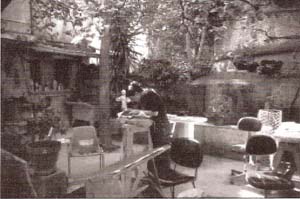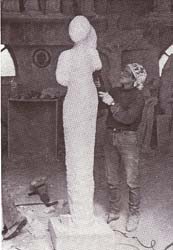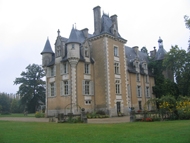
Home » Journal Articles » Travel » Journal from italia – Nov/Dec 1998
This spring I received an email from NWSSA member, M J. Anderson, describing an invitation from the Mayor of Rapolano to promote the international exchange of culture and the arts in Italy. We would meet up with 20 Japanese sculptors also invited to work in Rapolano. This was the second year for the Japanese. It was our first. This August, eight US sculptors (including NWSSA member Tamara Buchanan and myself) traveled to a little medieval hill-town outside Siena to carve together for a month. We worked in the studio of Mauro Berrettini, known for numerous public sculptures and piazzas throughout Italy, and Japan.
The work was organized by former NWSSA member, Claire McArdle, based in Annapolis, MD, who has worked in studios in Carrara, Italy, for over 10 years and has several public marble sculptures in Japan. Supporting us in the studio was Hanako Kumazawa, assistant for Berrettini and McArdle at the International Marble Sculpture Symposium, Mine, Japan.

August 1, 1998. Had a smooth flight to London, on to Milano, taxi to train station, express train to Firenze and a slow one to Siena. Called Rapolano from Firenze that we would be on the 22:00 and Claire was waiting for us in the dark, at the Siena terminal. By then, Tamara and I were at 24 hours travel time. We met the rest of the group at the ristorante in Serre. The Mayor of Rapolano, who had extended the invitation to us, was there to welcome us. We were driven up to our house about midnight. The casa looked exactly like you would imagine an Italian villa … high up on a hill with vineyards circling the grounds.
There are two parts to Rapolano–Serre (very small) and Terme (a little bigger!) only a few miles apart. No easy communication in Serre for us; no phones or mail delivery at the villa. We found two phone booths—-one at the truck stop on the highway and one up in the hill-town.
Our villa stood in the center of rolling green hills covered by grape vines, waist high sunflowers and, in lower areas, brown fields with four feet high rolls of hay. The red tile roofs of Serre stood high on a hillside above the traffic and trains. The narrow winding streets were only wide enough for very small passing cars traveling at high speeds which was intimidating to visiting sculptors! In the 12th century, Serre had a castle that was inhabited by imperials and was one of the first castles in the plans of Siena in 1174. There is a majestic wall that surrounds this multi-layered castle/town.
Serre is an artist’s dream. Very picturesque-the complete Italian scene, from the signora hanging clothes out her window three stories above me as I walked through the streets-to the stone carver. The church bells can be heard every morning in the clear air-and in the evening-well, dinner begins at 9!
The Mayor of Rapolano had arranged for us to have our meals and wine in Serre’s only ristorante-its door, with hanging beads, overlooked the winding streets and was only a 15 minute walk from our studio. It is owned by Umberto and Iva Braconi and was very busy. You eat what’s cooking-and the primo and secondo plates were excellent. Umberto usually started out by bringing in four tall bottles of

“acqua minerale” (bottled water) and by the time he would bring in the jugs of wine and baskets of bread, we had at least three empty water bottles and we were waiting for more. We would order plates of melon and prosciutto … choices of pasta, vegetables, salads and fruits … always exceptional!
We had the full experience of the Italian sun! By 8:00 am, the heat of the day had set in. However, the studio was cool until late afternoon. Perched on the edge of a large travertine marble quarry, the building is about 10,000 sq. ft. with 30 ft. high ceilings, which hold large beams with an overhead crane. Travertine stone is composed of almost pure calcium carbonate. Unlike Carrara marble, which is generally fine, close-grained and capable of taking a high smooth polish, travertine is quite porous with large pores and difficult to highly polish.
We had access to a whole room of air hammers, drills, saws, grinders, not to mention the hammers and chisels we needed. The pneumatic hammers were ltalian Culturi: Large (Type T) with \1,” shank openings all the way to Small (Type E) with 5/16″ openings. All with carbide pneumatic chisels. (I purchased a set of air hammers while there and shipped them back.)
Electric and pneumatic power tools were generally used from start to finish on local sculptors’ pieces. I discovered that filing and finish sanding was not usually done. The travertine’s surface is the likely reason for this different emphasis in finishing. However, when polishing by hand was required, we were supplied chunks of carborundum polishing wheels which had been broken into palm-sized pieces. We also had available some rifflers and a few sandpapers. Mauro demonstrated his method of “occasional” final polishing by rubbing a bar of polishing compound on an 8″ buffing wheel and attacking the piece from every direction until the shine satisfied him! Magnifico!
We had an interesting development on the 14″ of August. The 20 Japanese sculptors arrived and set up their carving areas in Rapolano Terme (about 5 miles away). They, too, were invited by the mayor, but they were also sponsored to produce large sculptures that remained in Rapolano’s outdoor sculpture park whereas we would be shipping our work back to America. All of us met on Monday and had lunch together in a community center close to the field. It was hot. The temperature stayed in the high 90’s. Some of the Japanese spoke a little Italian, and a little English, so when the mayor was making his presentation to us at a festa, we had Japanese translating the Italian language into English!

Typical in the work styles of the Japanese sculptors is their focus on their work. They arrived with only three weeks to complete their pieces. The stones, some weighing in at a ton, were lined up down the field and several were worked in place. Using air and hand tools, the majority of the sculptors carved in the direct sun with their wet towels still around their necks when they would meet us for lunch. Their intensity was also evident at the public dedication of their finished pieces when, on the field, they raised their flag amidst laughter and tears.
I observed this same concentration while working with Hanako back in our studio. In Italy, you can pay an artigiano to assist you in blocking out your work. I was faced with a 500 lb. block of stone and only a few days to learn all I could from Mauro, so I arranged for Hanako to assist me in pointing up my piece. Her focus and dedication were extraordinary. It was as though she was under a spell. I would arrive early and she would be hovering over the creature, redrawing over Mauro’s earlier outlines, and away we would go!
The hours spent at the studio extended from 8:30 am through 6 pm-with two hours taken for lunch-six days a week. A lot of work was being done throughout the studio areas and the scene was always foggy with the dust from the power tools., We found that a high priority was to keep plenty of acqua minerale in our possession. We bought it by the six-pack and always kept it in the cars and work places. The temperature did not give us a break at all the first three weeks, and a swim in the pool at the villa in the evening was something we never missed.
On Sundays, we went to locations with Marco, an art historian of the IS'” century. He took us to Siena and walked us through special areas of the Museo de Cathedral and into the Duomo where we stood before Bernini, Pisano, Michelangelo in awe. One week the Japanese sculptors and we were bussed along to Perugia and Assisi, and the last Sunday to Fireuze to see, among many things, Michelangelo’s Dawn & Dusk/Day & Night.
But during the week, the work went on. Much of the studio was stacked with huge pieces of stone. Mauro Berrettini is a master of the craft and his completed pieces were also in the studio, awaiting final installations. He is a gentle teacher, and easily shares his insight into the spirit of the stone. During the month, I worked on two pieces: the first, a small boy’s torso, was my study to learn the pneumatic tools, and was finished before the second week; the second was developed with Mauro’s perceptive guidance. His sculptures in the studio were larger-than-life size wolves and turtles, and their development was heavily entwined with myths. He would become very emotional as he described his concepts and it was easy to imagine these animals transforming into legends. My work has always been figurative; most of my designs center around people. A turning came about while I was working with Mauro.

Early one Saturday morning in the studio, I was preparing a model of what I hoped would be a gargoyle for Jim’s and my courtyard in Seattle. As the clay piece was developing, it was taking on a dragon-like demeanor. Mauro arrived, walked past me, stopped, turned around and said, “Molto bene!” In the next few seconds, he was joining me with clay in both hands, adding height to the angular spine I had built curving down the back and to the tip of the tail curled up against the dragon’s side. Hanako brought in more clay and formed a tongue sticking out between four huge teeth. (Mauro said this feature gives a blessing to the household!) By noon, we had completed the model for the Tuscan Creature. This modeling was taking place on top of a 500# cube of white travertine marble 32″x26″x24″. It was a natural to imagine the final in that stone! Within thirty minutes, Mauro had swung the boulder up from its location-over our heads~and down on a crate in my working area. Come Monday morning, I had work to do!
This was the type of teaching we received. Mauro and Hanako were very “hand’s on.” We didn’t have scheduled classes. The enthusiasm they felt for the work we were doing would draw them from one workplace to another—-criss-crossing across the studio all morning—demonstrating on one piece, commenting on another, and always with positive instructions and suggestions. Often in the evening, Mauro would wander among the stones, alone, and draw designs on them. We would arrive the next morning to a new interpretation of our piece drawn with red conte crayon!
The time moved quickly because of the heavy schedules. The little hill-town became my friend. I met the farmer who worked in the field as I walked into town-and the people who opened the bakery at 7 (maybe!!) and the owner who served cappuccino at her outside tables while the church bells were ringing. This experience was magical. Toscana va bene!
One Monday evening, we had a “thank you” supper at the villa around the pool for all the people we had worked with-Mauro, Claire, Hanako from the studio; Cesare, our villa caretaker; and the mayor was even invited! The pool lights were on and we had a beautiful gold/magenta sunset. The tables were filled with food and wine and as it was getting dark, we poured Vin Santo (a sweet dessert wine that is served with biscotti) and the conversation was going along very well when the Mayor drove up. He joined right in and the conversation became intense as he and Mauro agreed/disagreed about the philosophy of art in public places. It became a late evening!
We thanked the Mayor who. had the vision for this cultural exchange of sculptors to Rapolano and were impressed that he also hosted 15 children from Chernobyl to stay in homes in Serre for the month to improve their health. I became well acquainted with Olga Korolchuk, the children’s guide from Belarus. Some of the children came to swim in our pool on hot afternoons. I sympathized with the Italian foster parents as they struggled with their Russian reference books the same way we sculptors hunted through our Italian dictionaries for the right words.
The crates were ordered. On the last Saturday, all nine of them were filled one by one with the overhead crane-Mauro and Hanako punching buttons and stone swinging high above our heads. Three crates were destined for DC and four were to be shipped to Seattle. So for the next month or so, the marble Tuscan creature (chimera?) I had been working on would be somewhere on the high seas.

By this time, we were feeling the pending separation. On the last Monday, I spent time walking though the old town of Serre, saying goodbye to my new friends. Train schedules and flight confirmations were being made. Several were to leave on the 31″ and the last of us were scheduled for the I” of September. It takes more than 11 hours to fly from Milano/London to Seattle. The last night I drew the map of America for Mauro on our paper table covering at the ristorante and showed him where we all lived. It was hard to believe I was leaving bella Toscano.
Arrivederci, Patrizia.







We need some kind of descriptive text here.